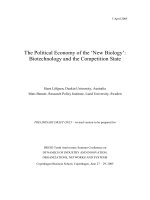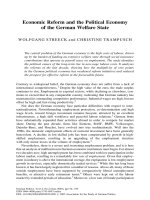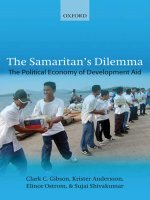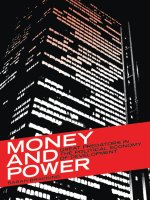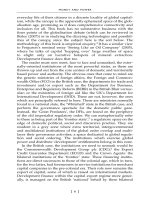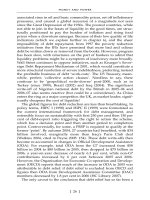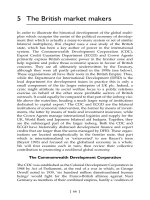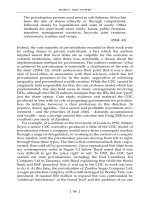State structure and economic development The political economy of Thailand and the Philippines
Bạn đang xem bản rút gọn của tài liệu. Xem và tải ngay bản đầy đủ của tài liệu tại đây (1000.21 KB, 317 trang )
STATE STRUCTURE AND ECONOMIC DEVELOPMENT:
THE POLITICAL ECONOMY OF THAILAND AND THE PHILIPPINES
by
ANTOINETTE R. RAQUIZA
A dissertation submitted to the Graduate Faculty in Political Science
in partial fulfillment of the requirements for the degree of Doctor of Philosophy,
The City University of New York
2010
UMI Number: 3397404
All rights reserved
INFORMATION T
O ALL USERS
The quality of this reproduction is dependent upon the quality of the copy submitted.
In the unlikely event that the author did not send a complete manuscript
and there are missing pages, these will be noted. Also, if material had to be removed,
a note will indicate the deletion.
UMI 3397404
Copyright 2
010
by ProQuest LLC.
All rights reserved. This edition of the work is protected against
unauthorized copying under Title 17, United States Code.
ProQuest LLC
789 East Eisenhower Parkway
P.O. Box 1346
Ann Arbor, MI 48106-1346
ii
© 2010
ANTOINETTE R.RAQUIZA
All Rights Reserved
iii
This manuscript has been read and accepted for the
Graduate Faculty in Political Science in satisfaction of the
dissertation requirement for the degree of Doctor of Philosophy.
Susan L. Woodward
Date
Chair of Examining Committee
Joe Rollins
Date
Executive Officer
John R. Bowman
Yan Sen
Supervision Committee
THE CITY UNIVERSITY OF NEW YORK
iv
Abstract
STATE STRUCTURE AND ECONOMIC DEVELOPMENT:
THE POLITICAL ECONOMY OF THAILAND AND THE PHILIPPINES
by
Antoinette R. Raquiza
Adviser: Professor Susan L. Woodward
This dissertation investigates the factors that account for different economic
performance among late developing countries that are vulnerable to external shocks,
crony capitalism, and political instability. The dissertation undertakes an historical,
comparative analysis of industrializing Thailand and relatively low-performing
Philippines, and argues that differences in economic performance are due to variations in
the institutional configuration of state power, defined along two dimensions: the
embeddedness of governing elites in state institutions, and the relationship between the
political leadership and economic technocracy in the development policy process.
The dissertation adopts the concept of bureaucratic polity, used in Thailand
studies, to refer to the series of coalitions between military rulers and senior technocrats
that controlled state power for most of that country’s modern history. Thai political rulers
and technocrat economic managers were deeply embedded, respectively, in the military
and civilian bureaucracies; economic technocrats had relative autonomy from the
political rulers. For the Philippines, this study introduces the concept of proprietary
v
polity, a form of elite rule in which personalistic politicians gain power because of their
personal wealth, connections, and political skills. Philippine political leaders belonged to
weak political parties and recruited technocrats from the private sector. Hence, the
development bureaucracy was strongly subordinate to political leaders.
These distinct institutional settings produced different economic growth patterns.
Thailand’s more stable bureaucratic polity proved conducive to long-term capital
accumulation, necessary for the rise of a robust industrial sector. Because political
contestation proved much more disruptive under the Philippines’s proprietary polity,
investment flowed more into the commercial sectors, where economic activities promised
fast turnovers. Four causal mechanisms link the institutional setting to economic
outcomes: (1) political contestation, 2) presence of policy continuity, 3) choice of policy
design and tools, and, 4) the consolidation of different policy constituencies
.
vi
ACKNOWLEDGEMENT
I welcome this opportunity to thank the many people who supported and helped
shape this dissertation. I owe a world of debt to my adviser, Susan L. Woodward, whose
relentless demand for clarity, consistency, and originality sharpened my analyses and
tightened my prose. Throughout my years at the Graduate Center, she gave me strong and
insightful feedback and advice. In consequence of her efforts, I am far better prepared
for my professional and academic life, and I am thankful for her hard work, for her high
standards, and for her ambitions for this project. I am grateful to my reader, John
Bowman, who kept me tuned in to the most interesting and relevant aspects of the
political economy literature and whose hard questions forced me to rethink some of my
analyses in ways that made this work far stronger than it would otherwise have been. Yan
Sun brought her expertise on Asian development to my dissertation committee, and I
have relied on her advice as well. Ruth O’Brien was the Executive Officer of the Political
Science Program for most of my time at the CUNY Graduate Center, and under her
leadership the program extended all manner of support, both in NY and while I was in the
field. During my field work, Jessica Landis provided me with sure-footed assistance that
helped me obtain the necessary support and permission to travel and connect with
different overseas academic institutions. I greatly benefited from many professors, but I
must extend specially thanks to Irving Leonard Markovitz who remained engaged with
my research interests throughout. His encouragement and advice about how I should
approach theory and practice helped propel me through graduate school.
vii
My field work was an incredibly enriching experience, and would not have been
so without the support of dear Thai and Filipino colleagues and friends. Jojo Abinales got
me started in Thailand by opening to me his vast social and academic network there, and
sharing his experience with the Thai academic community. I am especially grateful to
Pasuk Phongpaichit who facilitated my affiliation with the Political Economy Centre
(PEC) of the Faculty of Economics at Chulalongkorn University and generously shared
her analyses of Thai political economy. PEC Executive Director Kanoksak Kaewthep
provided me an intellectual and a logistical base from which I could study Thai policy
and politics and the unflagging Khun Pairin helped me get settled at Chula. I am deeply
indebted to Coeli Barry and Thanet Aphornsuvan, good friends and the best of
colleagues, who helped me arrange interviews, provided cheerful advice, and, in the end,
served as invaluable guideposts for the Thai side of this dissertation. For this dissertation,
I have had to rely on research papers and official documents written in English by Thai
and foreign scholars and policy analysts, and so the assistance of Coeli and Thanet in
helping me contextualize that English language material in the broader Thai discourse
was indispensible. English language scholarship and government documents exist in
abundance, but critical writings in Thai were beyond my reach. My discussion on
Thailand history in Chapter 3 is informed by Thanet’s specific comments, which helped
me wade through some of the conceptual debates in Thai studies, some of which directed
me to works I would otherwise have missed, some of which reflected his own research
and analysis. A vast number of other friends and colleagues, in one way or another,
helped me work and live in Bangkok: Donna Amoroso, Dottie Guerrero, Chonthicha
viii
Srisuk, Babette Resurrection, Edsel Sajor, Mike Montesano, Khanidtha Khanthawichai,
Tere Atienza, Chanida Bamford, Sumie Arima, and Jerome Ming: thank you all.
In the Philippines, I am grateful for the institutional support from the School of
Economics at the University of the Philippines. I am most indebted to Emmanuel
Esguerra who, as the School’s research director, has been an excellent adviser, colleague,
and friend: he introduced me to his economist friends in and out of the government, gave
valuable advice on my research, and became a sounding board for me on the Philippine
case. I thank Marivic Raquiza who kept me engaged in Philippine politics, referred me to
her colleagues in policy circles, and read chapter drafts with her usual critical eye.
Special thanks also to colleagues in the Philippine academia and political movements
who gave me contacts, leads, and all other forms of assistance, notably: Fidel Nemenzo,
Tesa Encarnacion-Tadem, Vera Razon, Pancho Lara, Men Sta. Ana, and Ed Tadem. I am
also grateful to Horacio “Boy” Morales who, as agrarian reform secretary, asked me to
work with him in government, and so gave me my first opportunity to experience how the
Philippine bureaucracy works. Eva Aurora Callueng assisted my Philippine data-
gathering. Finally, the rich data that I was able to get from my field work in the
Philippines would have been lost—literally, when my laptop was stolen in a laundry
shop—had it not been for Kuya Ricky, Oya Arriola, and others who helped me through
such a harrowing experience. In particular, Kit Belmonte and a group of his friends
provided security and advice for what became a cloak-and-dagger operation to retrieve
my laptop for a hefty ransom. Readers: back-up your hard-drives!
In between my field visits, I was fortunate enough to have been accepted in the
Cambridge Advanced Programme on Rethinking Development Economics summer
ix
session in 2007. Those meetings provided me a space to revisit theory in the midst of my
data-gathering. For this, I have Ha-Joon Chang and the Program to thank for. To all my
Thai and Filipino interviewees who generously shared with me their time, data,
anecdotes, and insights, my heartfelt thanks. Among my friends and colleagues with
whom I shared a big part of my graduate student days, I’d like to give special thanks to
Evren Balta, Fatimah Tahil, Sumie Nakaya, Danielle Zach, Nomvuyo Nolutshungu,
Annelies Kamran, Myrna Alejo-Brusco, Dulce Natividad, Noel Pangilinan, Cris
Godinez-Pangilinan, and Annelle Rivera-Beckstrom.
I am thankful for family, both in the Philippines and in the US. My Mom, Aida, as
well as siblings (Kuya Ricky, Ate Charito, Maan, Marivic, Joey, Rocky, and David) and
their families gave me the love and confidence to meet life’s challenges head-on. My
Mom has remained a constant in my life, despite my weaving in and out of hers, and for
this I am extremely grateful. Through this dissertation I also came to know more about
my Dad, Antonio, who gave his life to politics. Poring over congressional records, I
stumbled upon nationalist bills that he co-sponsored and speeches he gave in the 1960s—
giving me a glimpse of him as a nationalist, beyond his Ilocano roots, and (preciously)
beyond even my own experience of him. Here, and in other ways, my research proved a
personal journey, as well as an academic and professional one. Thank you to the Aragons
for their hospitality and generosity of spirit. I am also extremely grateful to the extended
family I have in the Boudreaus who welcomed me into their homes and have been a
constant source of encouragement and empathy. Most of all, my deepest thanks goes to
Vince, who knows me best and has been my rock, especially in the most trying of times.
Finally, this is for Zenaida Guzman and for remembering.
x
TABLE OF CONTENTS
ACKNOWLEDGEMENTS vi
TABLE OF CONTENTS x
.
CHAPTER I - INTRODUCTION 1
1.1. Review of Literature………… 7
1.2. Argument: Configuration of State Power and Economic Performance 28
1.3. Organization of the Dissertation …….
40
CHAPTER II –PATTERNS OF ECONOMIC GROWTH: NARRATIVES AND
REALITIES …………………………………………………………………… 44
2.1. Deconstructing Dominant Narratives. 47
2.1. a. Structure of the Economy …… 52
2.2. Two Tales of Economic Collapse and Survival 57
2.2. a. The Philippines and the 1983-1985 Debt Crisis…………………… 60
2.2. b. Thailand and the 1997-1998 Financial Crisis 67
2.3. Conclusion 78
CHAPTER III – STATE CONFIGURATION AND THE POLITICS OF
ECONOMIC POLICYMAKING ………………………… 81
3.1. Policymaking in Different Development Settings 83
3.2. Building the Modern State and Economy …………………………… 92
3.2. a. Thailand……………………………………………………………… 95
3.2. b. The Philippines……………………………………………………… 119
3.3. Synthesis and Conclusion 154
CHAPTER IV – COMPARATIVE POLICY DYNAMICS OF INVESTMENT
PROMOTION AND TRADE …………………………………………………….…165
4.1. Thailand and the Philippines: Background Conditions 168
4.2. Politics of Import-Substitution Industrialization 176
4.2. a. Thailand …… 178
4.2. b. Philippines……………………………………… ;……………… ….…….….188
4.3. Conclusion …………………………………………… 204
xi
CHAPTER V – THE ROAD TO NICHOOD … 210
5.1. Foundations of Export-Oriented Industrialization 214
5.1. a. Thailand……………………………………………………………… 222
5.1. b. The Philippines………………………………………………………… 238
5.2. Conclusion ………………………………………………………………… ……257
CHAPTER 6 – CONCLUSION 260
BIBLIOGRAPHY 280
xii
LIST OF TABLES
TABLE I. Annual Average Growth Rate of Real Per Capita GDP…………………………… 50
TABLE II. Simple Average of Tariff Rates…………………………………………… …….218
LIST OF FIGURES
FIGURE I. Thailand Sectoral Development………………………………….………….…… 53
FIGURE II. Philippine Sectoral Development………………………………… …………… 54
1
CHAPTER 1
Introduction
The Board of Investment (BOI) in Thailand sits at the outskirts of Bangkok in a
towering and pristine new building well-suited to its reputation as the powerful
impresario of the country’s industrial development. I had asked for an interview with the
agency’s head a week before, and had been quickly given an appointment by an efficient
staff member. On the morning of the meeting, I was ushered into a modern, brightly lit
conference room, obviously designed to receive CEOs and industry leaders. The
secretary general came in promptly and, assisted by a senior staff member, spent an hour
answering my questions.
1
He stressed Thailand’s specific advantages as an investment
site vis-à-vis its neighbors, discussing up-and-coming Vietnam with particular attention.
He also took time to defend the BOI against critics in Thai policymaking circles who
were at the time beginning to argue that the agency had outlived its usefulness. I left the
interview with two glossy brochures and a CD promoting Thailand as a site for foreign
investors and business activity. It was an altogether impressive showing: a demonstration
of modernity and efficiency designed to dazzle…and it did.
My first encounter with the Philippine Board of Investment (BOI) came at a
public consultation it sponsored to discuss the 2007 draft of its Annual Investment
Priority Plan (IPP), listing specific industries that would be entitled to BOI incentives.
1
Interview with Satit Chanjavanakul on November 7, 2006.
2
The meeting occurred in a poorly-lit conference room at the cramped BOI building in
Makati, Manila’s premier commercial district. The BOI building lies a short distance
from its head agency, the Department of Trade and Industry (DTI) and is led by a
department undersecretary. For the meeting, however, a panel consisting of only BOI
bureau directors and division chiefs met an audience that included a leading Filipino-
Chinese industrialist, the senior manager of a multinational steel corporation, some
Department of Finance representatives, and a Federation of Philippine Industries
officer—all seated on monoblock plastic chairs, flexing under the weight of so much
economic potential.
The panel opened by explaining what industries were not included in the draft,
and why: these were the “mandated inclusions” or economic activities that Congress had
for years legislated as entitled to fiscal and non-fiscal investment incentives. Also not
included were the economic activities that the departments (equivalent to ministries in
Thailand) needed still to identify and submit to the BOI. The chair of the panel explained
that since the BOI was constantly criticized for giving out incentives, the DTI Secretary
decided to have cabinet members share the responsibility of explaining to the President
and to the public why certain economic activities should be supported. Under the new
procedure, the BOI would consolidate the lists the departments would submit through
their cabinet secretaries.
This meeting, and subsequent visits to the Philippine BOI, revealed stark and
significant contrasts with the powerful and modern Thai BOI (in comparison to which,
the Philippine office seemed a poor cousin). As the public consultation suggested, the
BOI in the Philippines merely administers the investment incentives program; Thai BOI
3
officials actually make policy. While the Thai office had its critics, it responded by
defending its mission and asserting its bureaucratic prerogatives; in the Philippines,
officials sought instead to spread risk and potential blame, but also to diffuse power
among different executive agencies. Moreover, in the Philippines, incentives were
allocated around a wide variety of standing decisions, taken by Congress, to distribute
support to a range of interests.
2
Nothing of the sort intruded on the power of the Thai
BOI, which remains as the country’s most important allocator of investment incentives.
Hence, despite sharing the same name and some administrative functions, the two BOIs
occupied a different place in their countries’ development bureaucracies. This
dissertation will argue that such distinct institutional arrangements derive from variations
in the two countries’ patterns of economic development policy making and different
political dynamics.
My research seeks to explain differences in economic performances of Thailand
and the Philippines, treating the two countries as divergent cases of late-late industrial
development among Southeast Asia’s market economies. Analyses of Southeast Asian
economic development generally point to market liberalization and international free
trade as engines of growth (Pritchard 2006, Thomsen 1999). Thailand and Malaysia
2
Mandatory inclusions to the investment priority plan cover the following laws:
Presidential Decree No. 705 or the Industrial Tree Plantation Act; Republic Act No. 7103
on the iron and steel industry; RA 7942 on mining; RA 8047 on book publication or
printing; RA 8479 on the petroleum industry; RA 9003 on waste management; RA 9275
or the Clean Water Act; R.A 7277 on rehabilitation of disabled persons; and, RAs 6957
and 7718 on the build, operate and transfer arrangements.
From 1972 to 1998, there had been at least 44 laws passed on tax incentives.
Besides the industries and concerns cited above, Congress has also granted fiscal
incentives to specific business enterprises and constituent services such as tax benefits for
a local hospital or school (Llorito 2002).
4
registered growth rates of 8% and higher after their governments’ retreat from the
economy in the 1980s gave the private sector a greater role in industrial development.
Indonesia’s further liberalization since the collapse of the Suharto regime in May 1998
has also made it a key destination for foreign investors. These trends seem to uphold
arguments attributing the region’s growth economies to open markets (Bowie and Unger
1997). Conversely, analysts have typically explained poor economic performances—as in
the case of the Philippines under the Marcos regime, and Thailand during the 1997 Asian
financial crisis—in terms of graft and corruption (Campos 2001). Analyses of both
economic success and failure in the region, therefore, demonstrate strong faith in free-
market liberalism.
Yet there have always been problems with neoliberal explanations of Southeast
Asian development mainly because public authority and private power in the countries
have always been closely linked. My work seeks to explain the different economic
trajectories in the region by focusing on patterns of state activity in the economy. In fact,
the policymakers and governments in Southeast Asia’s market economies have played
decisive roles in building domestic capitalism. Ruth McVey (1992), for instance, argues
that because colonial administrations attempted to co-opt indigenous political elites by
recruiting them into the state bureaucracy while reserving the economy largely for
colonial exploitation, Southeast Asian capitalists first rose from the ranks of the
bureaucracy.
Since the start of the 20
th
century, emergent national political elites in the region
also undertook development programs that were designed, on the one hand, to modernize
an economy inherited from the colonial period and, on the other hand, to shore up their
5
political standing as claimants to the post-colonial state. Thailand holds the distinction of
never having been directly under colonial rule, yet the emergent bureaucratic elites that
seized control of the state from the monarchy in 1932 were similarly propelled by the
two-pronged objective of modernizing the economy and consolidating their rule. In this
light, development strategies that called for state corporations, import substitution, or
export promotion cannot be separated from political objectives.
From the standpoint of broad policy design, governing elites implemented
generally similar development strategies. Nevertheless, facing different political
conditions due to historical and colonial legacies, and drawing on different institutional
resources, those efforts produced divergent economic results.
This dissertation explains the divergence in economic performance of late
developing countries as a function of their different political economies. I argue that in
late-late developing countries the institutional configuration of state power exercises a
decisive influence on economic performance. I define the institutional configuration of
state power along two dimensions. It is, first, the embeddedness of the political
leadership and economic state managers in state institutions, and second, the pattern of
interaction and contestation among these governing elites, particularly as expressed in the
development policy process. In concentrating on this political and institutional story, this
study situates state activity at the center of the countries’ economic development.
To test this argument, I conduct an historical comparative analysis of Thailand
and the Philippines. Among Southeast Asian countries, Thailand and the Philippines
invite comparison for a variety of reasons. Although Thailand was never colonized, the
6
early development of its market economy was largely influenced by the demands of the
British Empire and other western countries. The Philippines, on the other hand, served as
the extension of the US market in the Pacific. Since their full integration into the global
economy in mid-19
th
century, the two countries have relied heavily on international trade
to raise revenues for state-building and economic development. Both also received US
economic and military aid during the Cold War. Thailand and the Philippines began the
1960s on almost equal economic footing, and from there, embarked on an industrial
development strategy of investment promotions led by the BOI with sharply different
results. Up until the mid-1990s, Thailand’s sustained growth marked it as a leader among
the region’s emergent second-generation newly-industrializing countries while the
Philippines has consistently occupied the last place among the region’s market
economies. In fact, Thailand began to distinguish itself as an industrializing country in
the mid-1980s at about the same time that the Philippine economy, an aspiring industrial
leader in the region in the 1950s, began seriously to falter. Given their similar starting
points and shared development strategies, what accounts for discrepancies in their
performance? The effort to explain this divergence will occupy the pages that follow.
The comparison between Thailand and the Philippines also allows me to control
for some potential alternative explanations for their contrasting economic performances.
Thailand and the Philippines both have had troubled polities: in both countries, transfer of
power generally is accompanied by polarization of contending factions within the ruling
circles. In Thailand, the traditional mode of resolving elite political conflicts had been
through coups d'etat; in the Philippines, electoral contests were traditionally accompanied
by violence and massive fraud. Thai and Philippine religious conflict also falls along
7
similar lines, pitting a militant flank of a Muslim minority against a dominant religio-
national group. Finally, indigenized Chinese capitalists dominate both economies, posing
similar questions about the economic role that ethnicity played. Thailand and the
Philippines, therefore, provide opportunities for a paired comparative analysis since they
allow me to control for these social and cultural factors.
Despite these areas of similarity, the countries do diverge in the way institutions
of state power were configured, and this difference provides the opportunity to trace out
the processes by which those configurations influence economic outcomes. More
broadly, an analysis of Thai and Philippine experiences can help clarify the development
dilemmas of many Third World countries—where development efforts are similarly
weighed down by colonial or historical legacies of unstable political regimes, dependent
capitalism, and social conflict.
Review of the Literature
Established theories of economic development tend to explain growth in terms of
two very different models: the free market model stresses the role of self-regulating
markets while the statist model points to the necessity of a strong, centralizing state. Both
arguments postulate a separate space for state and market forces: in the economic model,
the state retreats from the economy, and the market ensures the efficient allocation of
resources (World Bank 2002, Friedman 1999); in the political model, the state, relatively
insulated from social forces, steers the economy by mobilizing and allocating resources
to strategic sectors (Katzenstein 1985, Evans 1995).
8
That said, the dichotomy between these two schools of thought began to blur as
the question of late development drew more and more on multi-disciplinary studies
(Bates and Krueger 1993). An area where the two approaches seem most to converge is
around the study of institutions, particularly the linkages and patterns of interaction
between state and society actors (Portes 2006). In addition, some points of consensus
have developed around the roles the state can play in the domestic economy as late
developing countries face new opportunities and different risks given the changing rules
of globalization. Below, I first examine the sharply differentiated versions of the statist
and market-centered arguments before considering how newer institutionalist approaches
have been used to guide the study of late-late developing Southeast Asian cases.
Market-Driven Growth
Since the mid-1980s, the robust economic performance of Malaysia, Thailand,
Indonesia, and even the Philippines—generally referred to in the literature as the
ASEAN-4 countries
3
—has highlighted the role played by open economies. The ASEAN-
4’s dramatic growth, occurring as it did during the democratization wave of the 1980s
and 1990s, supported the argument linking economic performance and a liberalizing state
(Huntington 1992, Diamond 1999). Multilateral agencies like the World Bank stress that
Southeast Asia’s market economies grew as domestic regimes were retreating in both
political and economic ways. Some claimed that the governments came to see their
3
Malaysia, Thailand, Indonesia, and the Philippines are founding members of the
Association of Southeast Asian Nations.
9
economic role as primarily ensuring macroeconomic stability (Haggard 1989, Fukuyama
1999), and also noted the resulting surge in foreign investments (Pritchard 2006).
Statistical correlations between foreign capital inflow and the dramatic expansion of
export manufacturing in the ASEAN-4 countries reinforce a market-led explanation of
growth.
4
Basically, these analyses draw on neoclassical economic theory, which stresses
the importance of self-regulating markets as the way to grow the economy. Left
unfettered, the market, operating simply according to the law of supply and demand,
determines the most efficient allocation of resources. Factors of production, notably
capital and labor, flow to areas with higher productivity and (thus) the promise of
increasing returns; commodities are produced and exchanged using the price mechanism.
As Jeffry Frieden and Ronald Rogowski (1996) argue, prices are “the basic signal by
which economic information is transmitted, and therefore the proximate (if not
underlying) determinant of wages, rents, and other profits” (p. 29). In this world, market
competition is the causal mechanism that propels efficiency and innovation. As such,
neoclassical economists see the market as the lever for economic growth.
The problem with free market arguments, however, lies in their ahistorical and
clinical view. Factor accumulation and the efficient allocation of resources do lead to
growth, but whether these conditions derive from a free-wheeling market or from well-
4
For instance, Thomsen (1999) notes how the growth of ASEAN-4 countries’ exports
from 30.5% in 1989 to 39.7% in 1992 roughly corresponded with the rapid growth of
foreign direct investments (pp. 25-26). Citing how foreign direct investments had
generated jobs, promoted technology transfer, and raised government revenues, he argues
for governments to lift restrictive conditions such as local content requirements on
foreign investments.
10
timed government intervention is another question. In the histories of northern countries,
a centralizing state proved critical to industrialization (Chang 2002). Alexander
Gerschenkron (1962) pointed out in his study of 19
th
-century Russia that the state had to
provide resources for industrialization because European investment bankers did not find
the country’s “backward” economy appealing. The same situation prevails in late
developing countries as argued by Marcus Kurtz (2001) in his study of Chile’s high-
performing economy. Studying the export performances of three industries (forestry,
fishery and fruit-growing) in which Chile had a comparative advantage, he found that
only forestry and fishery, which received government assistance, expanded dramatically;
the fruit-growing industry, left mostly on its own, did not attract as much investment and
thus experienced middling growth. For his part, Dani Rodrik (2000) stresses that, despite
attempts to attribute China’s and India’s economic successes to liberalization, the two
countries’ economies first experienced high growth in the 1980s—more than a decade
before they actually lowered their tariff walls. In all these cases, state activity proved
critical in hastening economic growth. These cases suggest that neoclassical prescriptions
may be time- and condition-bound. Domestic and global conditions may well influence
whether neoclassical prescriptions, statist approaches, or some alternative will be most
appropriate to a country’s developmental objectives.
Upon deeper examination, neoclassical assumptions do little to explain Southeast
Asian economic development. Close links between politicians and business in these
countries (MacIntyre 1994, McVey 1992) constrain market competition—a defining
feature of liberal economies. Moreover, in some ways, the impact of liberalizing policies
11
runs directly counter to neoclassical expectations: the region’s most rigidly neoliberal
country, the Philippines, has also been the least economically successful (Bello 2000).
Statist conception of development
The literature on economic development increasingly regards the state as central
to this process. Studies of late industrializing countries in particular give states a central
role in facilitating capital accumulation and mobilization. Gerschenkron (1962) argued
that because of the indivisibility and complementarities of activities involved in industrial
development, central states needed to provide the “initial big push” and invest in
industrial development in order to transform agrarian economies and enable these
latecomers to compete in the international economy. Scholars from many different
traditions also broadly agree on the role of the state in the economy. Regarding economic
growth as a public good, rational-choice institutionalist perspectives see the state as
stepping in to resolve collective action problems (Olson 1977, Doner 1991). The
neomarxist tradition, in stressing the modern state’s structural dependence on capitalists
for public revenues and private investments (Block 1977, Przeworski and Wallerstein
1988, Swank 1992), asserts its critical role in maintaining and expanding capitalist
production (Jessop 1979, Offe and Ronge 1982).
From this broad consensus on the state’s key economic role, the question shifted
to issues of what state forms could best generate growth. Taking off from the literature
that sought to establish the state as an independent variable shaping societal, historical
processes (Evans 1995; Evans, Rueschemeyer, and Skocpol 1985), studies of the East
12
Asian economic miracles centered on the Weberian concept of the modern state,
characterized by a rational-legal authority, with a trained and tenured bureaucracy
exercising impersonal power (Pierson 1996; Evans and Rauch 1999). The presence and
active intervention of a competent state with an independent political will to restructure
the economy was, in this view, the catalyst that propelled Asia’s biggest economies.
Chalmers Johnson (1982) studied Japan’s high-speed growth, and developed the concept
of the developmental state in which a meritocracy used subsidized credit and other policy
tools to promote strategic, competitive industries. Studies of East Asian cases, notably
South Korea and Taiwan, support the idea that an interventionist, modernizing state was
key to economic success (Amsden 1985, Wade 1990).
In the main, the East Asian experience presented a path for late developing
countries that relied heavily on foreign capital and trade as sources of state revenues, and
adopted fairly similar development programs (World Bank 1993, Medhi 2000). That East
Asia prospered while other similarly situated economies in the 1960s and 1970s failed to
keep pace highlighted state agency in ensuring that resources go to industries with actual
or potential competitive advantages. Nevertheless, partly because the developmental
perspective stressed the state’s coherent and insulated character, it invariably presented
the state as a homogenous corporate entity—its parts subordinated to a central authority
able to wield public and private resources and shape the market almost at will.
Moreover, because the “state as organization” argument was first raised to debunk the
view of the state as simply an arena of social contestation or as extensions of the ruling
elites (Skocpol 1979), there was a tendency to underplay dynamics within the state itself.
